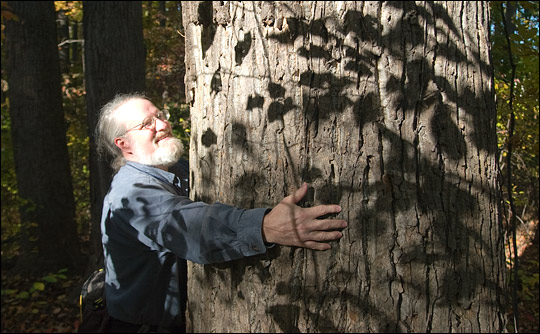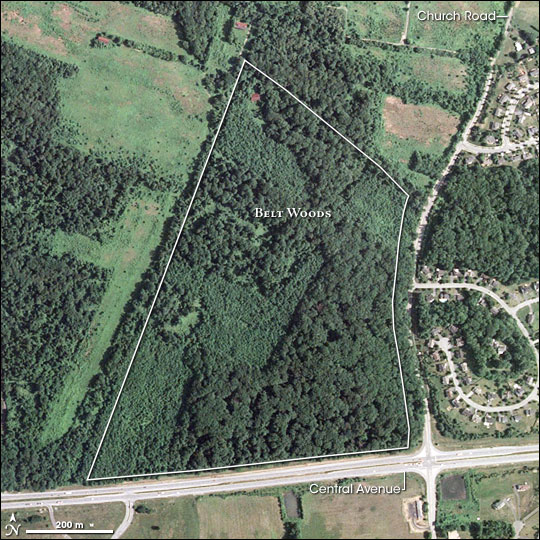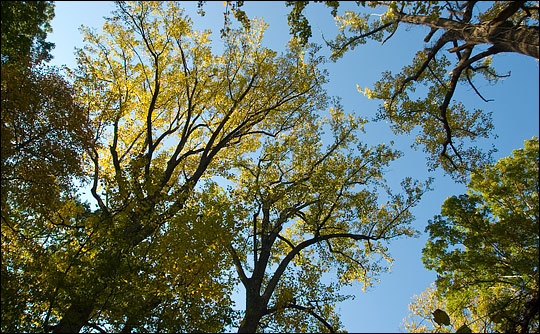

“Wow, that’s a beautiful tree.” Louis Steyaert has his head tipped back to make out the outline of the autumn leaves that cling to the uppermost branches of the giant tulip poplar. Tens of meters overhead, the trunk splits, the two branches racing towards a clear November sky. “How old do you think it is?” Steyaert asks, turning to his colleague, forest ecologist Robert Knox, who is respectfully considering the tree. Leaves crunch as Knox steps forward and embraces the mossy bark, his arms spanning perhaps two-thirds of the massive trunk. |
|||
 | |||
“At least pre-settlement,” he says, stepping back. Several of these giants are scattered across the sloped, 109-acre Old Belt Woods, which contains one of the last remaining tracts of virgin forest in the eastern United States. Steyaert and Knox have taken me to this tiny forest enclave to give me a firsthand experience of the kind of mature forest that once covered nearly the entire United States east of the Mississippi. |
NASA ecologist Robert Knox gauges the size of a tulip poplar in the Old Belt Woods. The tree is one of many centuries-old trees growing in the mature forest. Old Belt Woods is typical of the old-growth forests that once covered much of the eastern United States. (Photograph by Robert Simmon.) | ||
 | |||
“This is one typical sign of old growth,” says Steyaert, pointing to a large, centuries-old tree lying across the forest floor. A pit sinks behind the tree’s upturned roots. In forests regrowing on land that was once cleared and plowed, the pits left by falling trees are smoothed over. A truly ancient forest is crater-marked. In a nearby gap left by another fallen giant, a cluster of young tulip poplars compete to fill the space. The massive trees, fallen logs, gaps, and seedlings make the forest uneven; this unevenness is a hallmark of an old, multi-generational forest. |
Old-growth forest covers just part of the 109-acre Belt Woods, outlined in white. Geometric patterns of even green reveal that segments of the forest were once cleared and are now regrowing. One of the last fragments of native hardwood forest in the eastern United States, Old Belt Woods is only accessible to scientists by permit. (Aerial photograph courtesy Maryland DNR/National Agricultural Imagery Program.) | ||
 | |||
Is this what North America looked like when John Smith explored it? For Steyaert and Knox, the question is more than idle speculation. Plants interact with the atmosphere to influence local weather and climate. As the landscape changed from forest like Old Belt Woods to the suburban environment surrounding it today, did the weather change as well? Could future changes intensify or lessen global warming by tweaking local weather patterns? As we stand in the woods talking, the wind rushes through the uppermost branches, snapping the leaves that remain on the trees. Standing in the calm below, I can easily see how such large trees hold sway with the wind, but climate models need a different kind of description to reach the same conclusion. They need numbers that describe the shape, height, and color of the tree-tops and the density of the leaves because these are among the elements that talk to the atmosphere. |
Louis Steyaert and Robert Knox examine a decaying tree in Old Belt Woods. Since the tree had to have enough time to grow large, fall, and decay, it is a hallmark of an undisturbed, mature forest. Small trees cluster in the space where the tree once stood, competing to fill the opening in the canopy. (Photograph by Robert Simmon.) |
||
 | |||
Describing landscape changes in the eastern United States since colonization began and translating those descriptions into numbers models can use was the Herculean five-year task that the pair of scientists standing in Old Belt Woods with me that fall day had just completed. Using everything from observations recorded by naturalists and foresters throughout the past 150 years to data from Earth-orbiting satellites, Steyaert and Knox created a series of maps that reconstruct the landscape as it would have appeared in 1650, 1850, 1920, and 1992. These maps provide the hard numbers that climate modelers need to determine what effect landscape changes might have had on the weather in the eastern United States. |
The tallest trees in Old Belt Woods soar tens of meters overhead. Shorter trees and gaps make the canopy uneven, a trait of a multi-generational forest. Forests regrowing on land that has been cleared tend to have a smooth canopy, made up of trees that are all roughly the same age. The uneven canopy of an old-growth forest interacts with the atmosphere differently than the smooth canopy of a regrowing forest, so cutting a forest down may alter local weather patterns. (Photograph by Robert Simmon.) | ||